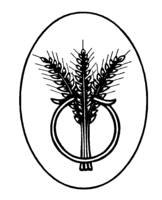The Eaton Internment Historic Site Project was designed as a PCUH community outreach initiative. The objective of the project, which actively involved the Ukrainian community and others, was to provide institutional support for the creation and establishment of a permanent memorial honouring the memory of East European immigrants designated ‘enemy aliens’ interned as prisoners of war at the Eaton railway siding in Saskatchewan during WWI.
The project was made possible with the co-operation of the Saskatchewan Railroad Historical Association. The Association operates the Saskatchewan Railway Museum, situated on the site of the original internment camp and located four kilometers southwest of Saskatoon at the junction of Highway 60 and the Canadian National Railway.
A large tyndall stone and bronze memorial, specially commissioned and designed, was unveiled at a commemorative ceremony held September 24, 2004. The memorial was designed by nationally acclaimed artist Grant McConnell and local stone mason Rob Assie.
Between the years 1914-1920, under the provisions of the War Measures Act, 8,579 civilian immigrants of enemy alien origin – former nationals of countries at war with Canada – were interned as prisoners of war. In October 1918, sixty-five inmates of the Morrissey Internment Camp (Fernie, British Columbia) were relocated to a special holding facility created at Munson, Alberta where they would repair and lay new track on the Goose Lake Line. The Spanish Influenza and a subsequent train wreck forced the relocation of the Munson camp to the railway siding at Eaton, Saskatchewan in early March 1919. Disciplinary problems forced the Eaton camp to be abandoned in favour of more secure facilities at Amherst, Nova Scotia to which the prisoners were transferred by the end of March 1919.
The Eaton Internment Camp was one of 26 camps created as places of internment during World War I for civilian enemy prisoners of war. It was the only facility of its kind in Saskatchewan and constitutes an important provincial historic site.
